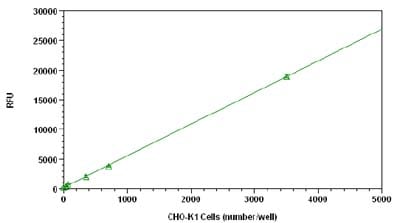Cell Viability Assay Kit (Fluorometric - Dual Green/Red) (ab112121)
Key features and details
- Assay type: Quantitative
- Detection method: Fluorescent
- Platform: Microplate reader, Fluor. microscope, Flow cyt.
- Sample type: Adherent cells, Suspension cells
Overview
-
Product name
Cell Viability Assay Kit (Fluorometric - Dual Green/Red)
See all Cell Viability kits -
Detection method
Fluorescent -
Sample type
Adherent cells, Suspension cells -
Assay type
Quantitative -
Species reactivity
Reacts with: Mammals, Other species -
Product overview
Abcam's Cell Viability assay kits are a set of tools for monitoring cell viability and cellular functions. ab112121 uses two non-fluorescent indicators: The CellGreen fluorescent dye for viable cells and a cell-impermeable DNA-binding dye for the cells with compromised membranes. The non-fluorescent Green Indicator Dye can easily permeate intact live cells and is hydrolyzed by intracellular esterase to generate the strongly fluorescent hydrophilic CellGreen fluorescent dye which is well-retained in the cell cytoplasm. The esterase activity is proportional to the number of viable cells. The DNA-binding dye is quite polar and impermeable for viable cells that have intact membranes. It becomes fluorescent only upon binding to the DNA of dead cells. Cells grown in black-wall plates can be stained and quantified in less than two hours.
ab112121 is more robust and accurate than the other viability assays. It can be readily adapted for a wide variety of fluorescence platforms such as microplate assays, fluorescence microscope, and flow cytometry. The kit provides all the essential components with an optimized assay protocol. It is suitable for both proliferating and non-proliferating cells (either suspension or adherent cells). ab112121 comes with sufficient reagents to perform either 200 assays (96-well format) or 800 assays (a 384-well format).
-
Notes
ab112121 should be stored desiccated.Assay kit comes with sufficient reagents to perform either 200 assays (96-well format) or 800 assays (a 384-well format).
Related assays
Review the cell health assay guide to learn about kits to perform a cell viability assay, cytotoxicity assay and cell proliferation assay.
-
Platform
Microplate reader, Fluor. microscope, Flow cyt.
Properties
-
Storage instructions
Store at -20°C. Please refer to protocols. -
Components 2 x 96 tests Assay Buffer 1 x 20ml CellGreen fluorescent dye 2 vials DMSO 1 x 100µl Propidium Iodide 1 x 40µl -
Research areas
-
Relevance
Cell viability is a determination of living or dead cells, based on a total cell population. Cell viability assess healthy cells in a sample, with no distinction between dividing or quiescent cells. An increase in cell viability indicates cell growth, while a decrease in viability can generally be interpreted as the result of either toxic effects of compounds/agents or suboptimal culture conditions. -
Alternative names
- cell tracking
Images
-
CHO-K1 cell number response was measured with ab112121. CHO-K1 cells at 0 to 5,000 cells/well/100 µL were seeded overnight in a black wall/clear bottom 96-well plate. The cells were incubated with 100 µL/well of Green dye-loading solution for 1 hour at 37 °C. The fluorescence intensity was measured at Ex/Em = 490/ 525 nm. The fluorescence intensity was linear (R2 = 1) to the cell number as indicated. The detection limit was 30 cells/well (n=6).
Datasheets and documents
-
SDS download
-
Datasheet download
References (0)
ab112121 has not yet been referenced specifically in any publications.
